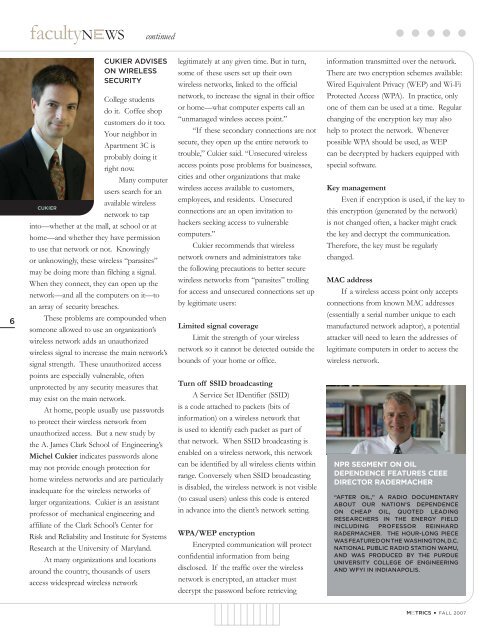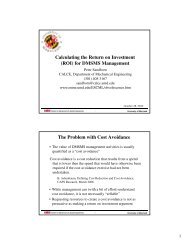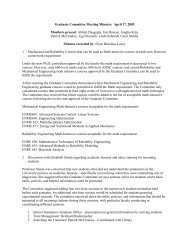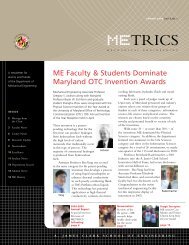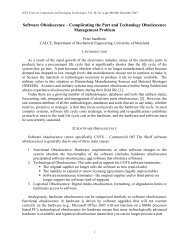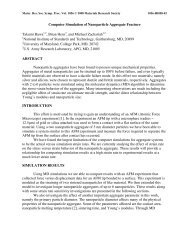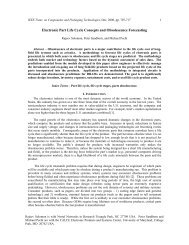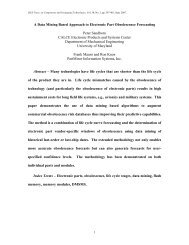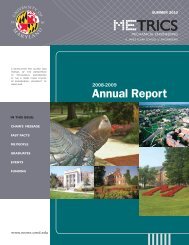METRICS - Mechanical Engineering - University of Maryland
METRICS - Mechanical Engineering - University of Maryland
METRICS - Mechanical Engineering - University of Maryland
You also want an ePaper? Increase the reach of your titles
YUMPU automatically turns print PDFs into web optimized ePapers that Google loves.
6<br />
facultyNEWS continued<br />
CUKIER ADVISES<br />
ON WIRELESS<br />
SECURITY<br />
College students<br />
do it. C<strong>of</strong>fee shop<br />
customers do it too.<br />
Your neighbor in<br />
Apartment 3C is<br />
probably doing it<br />
right now.<br />
Many computer<br />
users search for an<br />
available wireless<br />
CUKIER<br />
network to tap<br />
into—whether at the mall, at school or at<br />
home—and whether they have permission<br />
to use that network or not. Knowingly<br />
�������������������������������������������<br />
may be doing more than filching a signal.<br />
When they connect, they can open up the<br />
network—and all the computers on it—to<br />
an array <strong>of</strong> security breaches.<br />
These problems are compounded when<br />
someone allowed to use an organization’s<br />
wireless network adds an unauthorized<br />
wireless signal to increase the main network’s<br />
signal strength. These unauthorized access<br />
points are especially vulnerable, <strong>of</strong>ten<br />
unprotected by any security measures that<br />
may exist on the main network.<br />
At home, people usually use passwords<br />
to protect their wireless network from<br />
unauthorized access. But a new study by<br />
the A. James Clark School <strong>of</strong> <strong>Engineering</strong>’s<br />
Michel Cukier indicates passwords alone<br />
may not provide enough protection for<br />
home wireless networks and are particularly<br />
inadequate for the wireless networks <strong>of</strong><br />
larger organizations. Cukier is an assistant<br />
pr<strong>of</strong>essor <strong>of</strong> mechanical engineering and<br />
affiliate <strong>of</strong> the Clark School’s Center for<br />
Risk and Reliability and Institute for Systems<br />
Research at the <strong>University</strong> <strong>of</strong> <strong>Maryland</strong>.<br />
At many organizations and locations<br />
around the country, thousands <strong>of</strong> users<br />
access widespread wireless network<br />
legitimately at any given time. But in turn,<br />
some <strong>of</strong> these users set up their own<br />
wireless networks, linked to the <strong>of</strong>ficial<br />
network, to increase the signal in their <strong>of</strong>fice<br />
or home—what computer experts call an<br />
�����������������������������������<br />
“If these secondary connections are not<br />
secure, they open up the entire network to<br />
�������������������������������������������<br />
access points pose problems for businesses,<br />
cities and other organizations that make<br />
wireless access available to customers,<br />
employees, and residents. Unsecured<br />
connections are an open invitation to<br />
hackers seeking access to vulnerable<br />
������������<br />
Cukier recommends that wireless<br />
network owners and administrators take<br />
the following precautions to better secure<br />
��������������������������������������������<br />
for access and unsecured connections set up<br />
by legitimate users:<br />
Limited signal coverage<br />
Limit the strength <strong>of</strong> your wireless<br />
network so it cannot be detected outside the<br />
bounds <strong>of</strong> your home or <strong>of</strong>fice.<br />
Turn <strong>of</strong>f SSID broadcasting<br />
A Service Set IDentifier (SSID)<br />
is a code attached to packets (bits <strong>of</strong><br />
information) on a wireless network that<br />
is used to identify each packet as part <strong>of</strong><br />
that network. When SSID broadcasting is<br />
enabled on a wireless network, this network<br />
can be identified by all wireless clients within<br />
range. Conversely when SSID broadcasting<br />
is disabled, the wireless network is not visible<br />
(to casual users) unless this code is entered<br />
in advance into the client’s network setting.<br />
WPA/WEP encryption<br />
Encrypted communication will protect<br />
confidential information from being<br />
disclosed. If the traffic over the wireless<br />
network is encrypted, an attacker must<br />
decrypt the password before retrieving<br />
information transmitted over the network.<br />
There are two encryption schemes available:<br />
Wired Equivalent Privacy (WEP) and Wi-Fi<br />
Protected Access (WPA). In practice, only<br />
one <strong>of</strong> them can be used at a time. Regular<br />
changing <strong>of</strong> the encryption key may also<br />
help to protect the network. Whenever<br />
possible WPA should be used, as WEP<br />
can be decrypted by hackers equipped with<br />
special s<strong>of</strong>tware.<br />
Key management<br />
Even if encryption is used, if the key to<br />
this encryption (generated by the network)<br />
is not changed <strong>of</strong>ten, a hacker might crack<br />
the key and decrypt the communication.<br />
Therefore, the key must be regularly<br />
changed.<br />
MAC address<br />
If a wireless access point only accepts<br />
connections from known MAC addresses<br />
(essentially a serial number unique to each<br />
manufactured network adaptor), a potential<br />
attacker will need to learn the addresses <strong>of</strong><br />
legitimate computers in order to access the<br />
wireless network.<br />
NPR SEGMENT ON OIL<br />
DEPENDENCE FEATURES CEEE<br />
DIRECTOR RADERMACHER<br />
“AFTER OIL,” A RADIO DOCUMENTARY<br />
ABOUT OUR NATION’S DEPENDENCE<br />
ON CHEAP OIL, QUOTED LEADING<br />
RESEARCHERS IN THE ENERGY FIELD<br />
INCLUDING PROFESSOR REINHARD<br />
RADERMACHER. THE HOUR-LONG PIECE<br />
WASFEATURED ON THE WASHINGTON, D.C.<br />
NATIONAL PUBLIC RADIO STATION WAMU,<br />
AND WAS PRODUCED BY THE PURDUE<br />
UNIVERSITY COLLEGE OF ENGINEERING<br />
AND WFYI IN INDIANAPOLIS.<br />
<strong>METRICS</strong> � FALL 2007


